A group of researchers has introduced an innovative technique for the early prediction of the direction of coronal mass ejections (CME) in 3D space. This groundbreaking method, known as DIRECD—”Dimming InfeRred Estimate of CME Direction,” will offer vital information to minimize potential negative impacts on various industries and technological systems, both in space and on Earth.
Coronal mass ejections are massive magnetic plasma bubbles that are expelled from the sun into the surrounding space at speeds ranging from several hundred to several thousand kilometers per second. If the bubble of charged particles is aimed at Earth, it could trigger geomagnetic storms and polar auroras upon reaching the Earth’s magnetosphere, leading to significant issues in the operation of space- and ground-based technological systems and posing radiation hazards for astronauts.
Unfortunately, detecting a coronal mass ejection early on is currently quite difficult, as it typically becomes visible only at an advanced stage when it appears in the field of view of specialized instruments called coronagraphs, which create an artificial solar eclipse by obscuring the solar disk by several of its radii. To address this challenge, the DIRECD method uses indirect traces of coronal mass ejections on the sun—coronal dimmings, which are dark areas in extreme ultraviolet images—to estimate the propagation direction of a coronal mass ejection in 3D space at an early stage.
Dimmings are caused by the expansion and ejection of matter from the solar corona during a CME. The current research and the DIRECD method are the result of earlier work, where the team demonstrated the potential of coronal dimmings for detecting and analyzing CMEs at an early stage in their evolution.
Shantanu Jain, a Skoltech Ph.D. student and the lead author of the study, expressed excitement about the method’s capabilities, stating, ”Our method can provide early insight into the propagation direction of the CME even before it is observed by coronagraphs on board satellites. It is amazing that we can accurately estimate 3D parameters of the CME such as 3D direction with just 2D dimming information extracted from solar images at a very early stage of the solar eruption.”
2024-02-06 02:00:04
Article from phys.org
